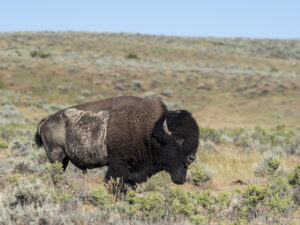
Some suggest, however, that the risk of cows contracting brucellosis is low. “Theoretically there is a risk, but it’s so low that it doesn’t justify the way the bison are managed,” says Matt Skoglund, wildlife advocate at the National Resources Defense Council. Since 2005, more than 2,500 bison have been slaughtered; this allows Montana to keep its brucellosis-free status and avoid losing millions of dollars in the unlikely case of an outbreak. In other words, risk aversion at its most extreme. “With proper management you can make the risk very small-the livestock industry wants zero risk, which doesn’t exist,” says Keith Aune, senior conservation scientist at the Wildlife Conservation Society.
For cattle to be exposed to the disease, they would need to come into direct contact with infected birthing fluids or tissue, which isn’t bound to happen for a number of reasons, according to Yellowstone.net. Cattle occupy that land during the summer, while bison are there in the winter, and most of the domestic cattle in the Yellowstone area have already been vaccinated.
“Brucellosis is just a smokescreen,” says Tom Woodbury with the Western Watersheds Project. “Ranchers in Montana are used to having a monopoly over public lands grazing. They want to keep bison away because they’d inhabit the same areas that they lease from the government for less money than it costs to feed a hamster.” Todd Graham, president of Aeroscene Land Logic, believes it’s political. “There’s no question that ranchers’ impact on government decisions is huge,” he says. “It’s a matter of self-preservation-public wildlife is a threat to their private property and well being.”
Killing thousands of bison is a preventative measure taken too far, and the facts don’t support it. When bison are hazed and test positive for antibodies to brucellosis, they are slaughtered and donated to an Indian tribal organization or charity, under the State of Montana Code 81-2-120. But these test results don’t signify that they have the disease or could spread it-it simply means they have been exposed to it and, often, have developed immunity.
Another inconsistency is that while there are around 3,000 bison in Yellowstone, there are approximately 100,000 elk that are exempt from the slaughter policy, even though they show signs of having the disease. What gives? It’s about money, says Graham, noting that elk are profitable for hunting and a multi-billion-dollar industry in the Rockies. “Elk are politically easier to deal with,” adds Skoglund.
Efforts are underway by some groups to change the way Yellowstone bison are managed. The Gallatin Wildlife Association is trying to gain support for its 2011 Wild Buffalo Recovery and Conservation Act. The group wants bison to be recognized as “valued, native wildlife in the state of Montana” and to make Montana Fish, Wildlife and Parks the primary agency responsible for the animal’s management (There are currently six government agencies overseeing them). The National Park Service is also reviewing a 30-year $9-million program that would vaccinate Yellowstone bison via air pellets.
“We need a paradigm shift,” says Aune. “People are myopic in Yellowstone right now and can’t see other options.” One alternative would be to give surrounding areas a monetary incentive to monitor the bison, making them an asset to private land owners. Then there are the government regulations, which warrant a tweak. Livestock producers would be less inclined to back bison slaughter if they weren’t so afraid of the state’s rigid laws. “Relax the regulations,” says Skoglund. “Outbreaks could be contained; there’s no need to depopulate the entire herd.”
One thing is certain if conflicts over wildlife that seem to pose a threat are to be resolved: Bison advocates must gain the support of local ranchers. “We need to find a way to make bison economically viable again,” says Graham.


